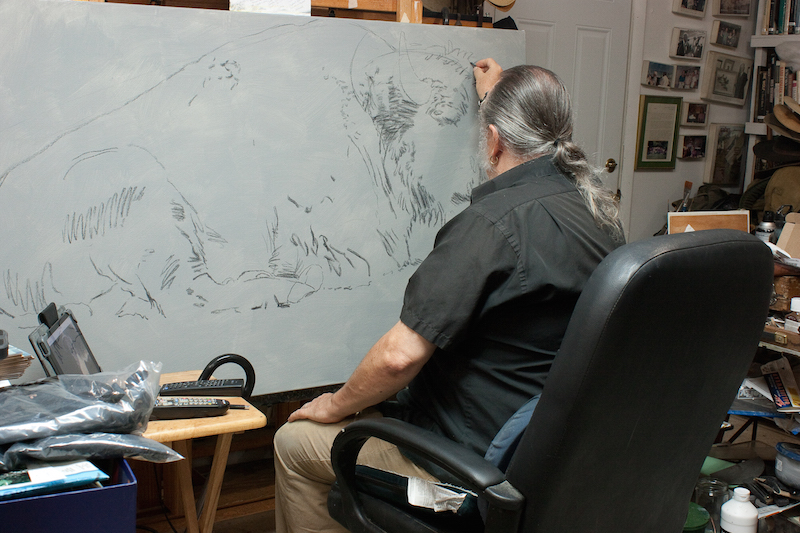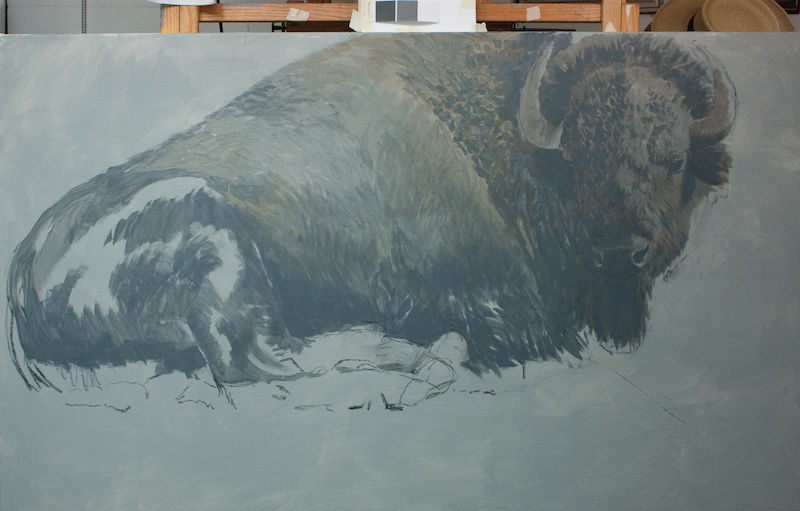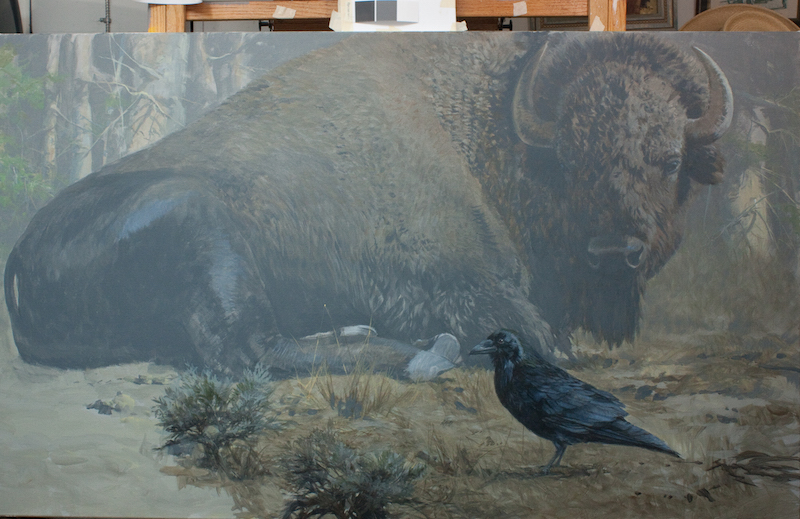Internationally renowned master wildlife artist, John Seerey-Lester is well known for the art of painting big, dramatic paintings that tell a story.
Specializing in wildlife, sporting art, and historic themes, John has gained a reputation for producing images in either oil and acrylic with a narrative which are both mysterious and mystical.
John is also a famed painting instructor. In fact, I first met John in Colorado nearly 30 years ago at one of his popular wildlife workshops. From John, I learned ways to improve my own wildlife painting skills which I still use when creating my art today. You can imagine how thrilled I was when John agreed to contribute a special painting demonstration to my North Light Book, Fine Art Tips with Lori McNee
thrilled I was when John agreed to contribute a special painting demonstration to my North Light Book, Fine Art Tips with Lori McNee
Painting Techniques and Professional Advice. It is my honor to share another demo of John’s here on my blog. If you enjoy this demo, please consider purchasing my book where 24 of today’s finest artists reveal their painting secrets!
Meanwhile, please enjoy these Easy Steps to Painting Big by John Seerey-Lester
As previously mentioned, I like to tell a story with my paintings. I am fascinated with Native American history. With this painting I chose to focus on Native American lore.
The raven listens to the bison and all the other animals in the area. He knows what is happening, the raven is known for keeping secrets. This is why I titled this painting, The Keeper of Secrets.
Step 1 The Drawing
Prime Belgium Linen canvas, with a mid gray acrylic (mix Paynes’s gray, burnt umber and Ultramarine blue in equal parts, then add white gesso until satisfied with the strength of the gray, use a 2” nylon house painting brush to apply).
Using vine charcoal sketch in the bison. At this point, makes sure the bison is accurate. I use sketches done in the field. It is imperative that you know the animal you are painting and make sure you know the muscle structure, type of fur, and even eyes. This will make or break your painting.
Step 2 The Block-in
Using Raw Umber and Paynes Gray, block-in the bison, with a 1” Flat or Rake brush. The bison will be in the mid-ground.
It is important to use the proper value in the colors. Mix several pots of different values of gray to add to the color of the subject to insure the values stay where you want them. The lighter gray will be used in the background, middle value gray for the mid-ground, and darker gray values in the foreground.
Step 3 The Raven
Now, add the raven using a 1 “Flat brush and a mixture of Payne’s Gray and raw umber. Again I am using my own reference sketches, and also a mount of a raven. This will help me get the detail of the shimmering iridescent colors on the black bird. To achieve this, use yellow ochre and ultramarine blue, with a touch of cad yellow. Then apply raw umber between the dark and the sheen of the feathers.
The darker values of the raven bring it forward, and automatically push the bison back. When painting big, scale is very important – you want to make sure the bird is the correct size to create distance from the bison.
Step 4 The Background & Foreground
Again using the proper values, paint in the background. The background is lighter and cooler than the bison, and the raven.
The foreground and sage are added. Here, I used reference from a sketch done in Yellowstone but eventually eliminated the sage as it made the painting too fussy and could confuse the composition.
Use a 1” Flat with the light gray mix and a little ultramarine blue, raw umber and cad yellow to create the illusion of foliage.
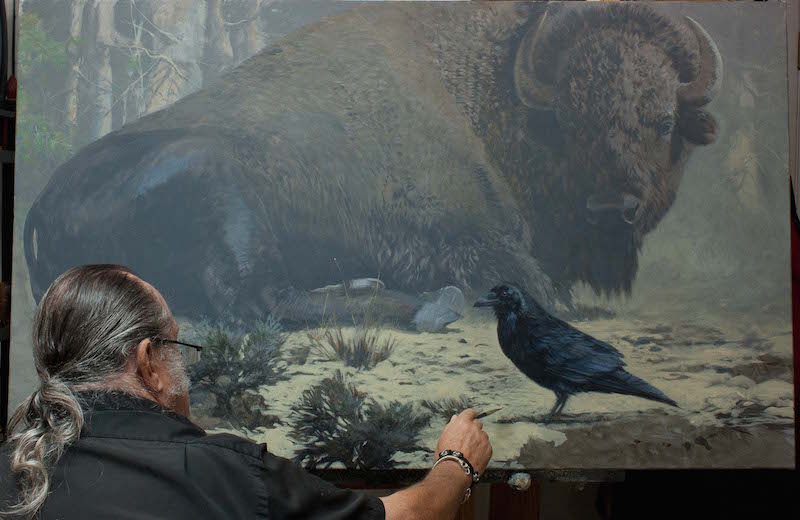
Step 5 Making Changes
I’ve decided to change the foreground to dusty sand that bison love to lay in. Using a mixture of Naples yellow and raw umber with a 1” Flat brush, establish the base ground color. Then add the grasses, stones and indentations in the sad with raw sienna, raw umber and in some areas Payne’s gray.
Keeper of the Secrets is finished.
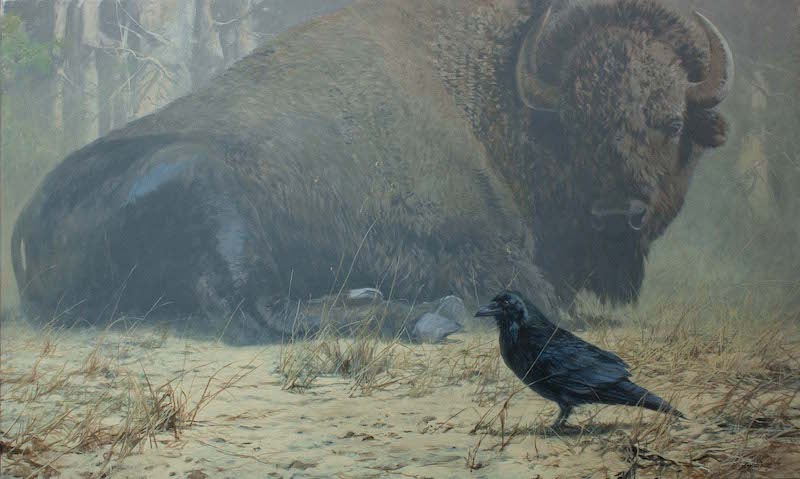
Guest artist/author: With work hanging at the White House and in permanent, private and Museum collections, throughout the world, John Seerey-Lester has become one of the most renowned of today’s wildlife and historic artists. Published by Mill Pond Press, John has had over 400 different limited edition prints produced over the years, which led to him being one of the most sought after artists.


